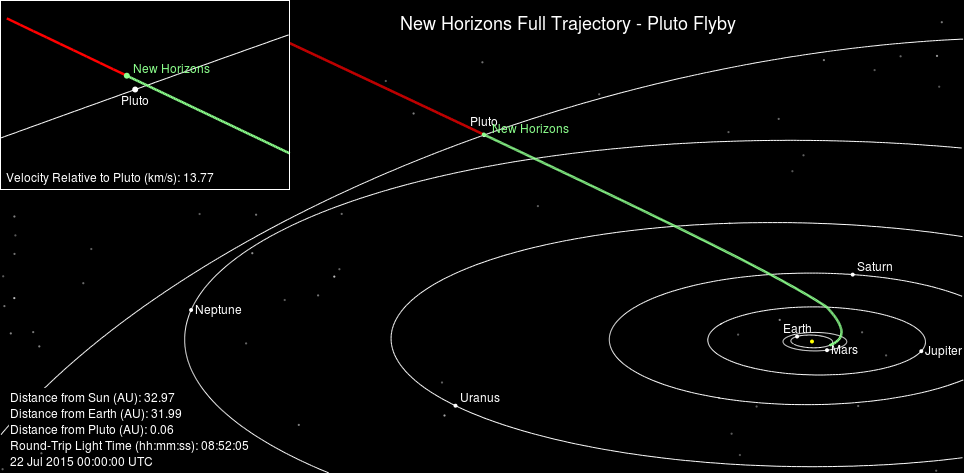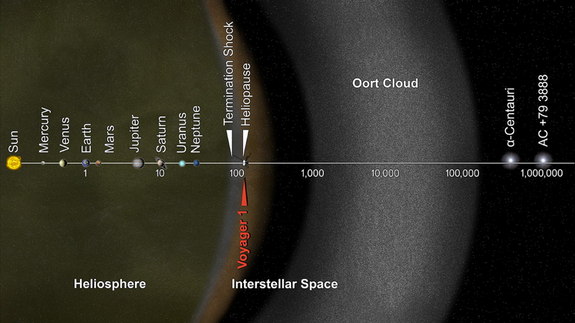Carl Sagan on New Horizons
 Thursday, July 23, 2015 at 11:31AM
Thursday, July 23, 2015 at 11:31AM After nine and half years of flying through space, NASA’s New Horizons spacecraft reached Pluto, which, depending on its location in orbit relative to Earth, is anywhere between 30 to 49 astronomical units away (one AU is equal to 93 million miles, the distance from Earth to the Sun). Measured in miles, Pluto’s distance from Earth lies between 2.7 billion and 4.5 billion miles away, depending when the measurement is taken.  Image from: https://en.wikipedia.org/wiki/New_Horizons#/media/File:New_Horizons_Full_Trajectory_Sideview.png
Image from: https://en.wikipedia.org/wiki/New_Horizons#/media/File:New_Horizons_Full_Trajectory_Sideview.png
At 40 AU, Pluto is extremely far, but Voyager 1 spacecraft, launched in 1977, is the farthest human-made spacecraft from Earth. At 132 AU (or 12.2 billion miles) away, Voyager 1 is expected to reach the star Gliese 445 in the constellation Camelopardais in another 40,000 years, by which time microbes and bacteria on Earth may once again be intermingling in a primeval soup in the beginnings of an evolutionary course eventually spawning intelligent life on Earth, ideally without the propensity toward collective suicide and unrestrained violence. New Horizons was traveling at 50,000mph on its brush with Pluto, and transmitted high-resolution images of the surface of which indicate a geologically active dwarf planet complete with a thin nitrogen atmosphere and surface features attributing to wind and sub-surface heat. Interstellar space (where plasma lies beyond the reaches of the Sun) is roughly 125 AU away, and New Horizons is expected to join Voyager 1, 2, and Pioneer 10, and 11, as the only ships from earth to venture into this far-off realm, perhaps to one day enter intergalactic space, the space between galaxies.

Image from: http://www.space.com/22797-voyager-1-interstellar-space-nasa-proof.html
Although the Hubble Space Telescope keeps tallying more galaxies, scientists currently estimate that the universe contains 170 billion galaxies, and the number of stars within these galaxies exceeds one septillion, which is a 1 followed by 24 zeroes. According to Carl Sagan and others, there are more stars in the universe than all the grains of sand in all the beaches on Earth.
In Cosmos, Carl Sagan discusses how humans have used science and technology to explore the planet, as well as how our ability to traverse space has advanced over time. According to Sagan, if the progression of science and the inquisitiveness nature of the human spirit is maintained, "If we do not destroy ourselves, we will explore the stars."
In the 15th and 16th centuries, you could travel from Spain to the Azores in a few days – the same time it takes now to cross that little channel from Earth to the moon. It took then a few months to traverse the Atlantic Ocean to reach what was called the New World: the Americas. Today it takes a few months to cross the ocean of the inner solar system and reach Mars and Venus, which are truly and literally new worlds awaiting us. In the 17th and 18th centuries you could travel from Holland to China say, in a year or two, the same time it takes Voyager to travel from the Earth to Jupiter. And in comparison to the resources of the society, it cost more then to send sailing ships to Far East than it does now to send spaceships to the planets… If we do not destroy ourselves, we will explore the stars.
-Carl Sagan, Cosmos, Travellers' Tales

Reader Comments